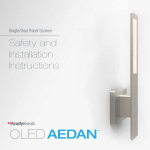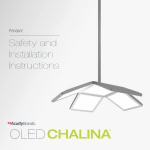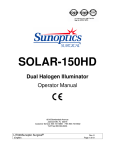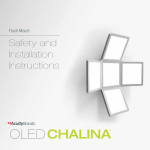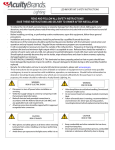Download Lithonia Lighting AFST 2 32 MVOLT GEB10IS Instructions / Assembly
Transcript
READ AND FOLLOW ALL SAFETY INSTRUCTIONS! SAVE THESE INSTRUCTIONS AND DELIVER TO OWNER AFTER INSTALLATION To reduce the risk of death, personal injury or property damage from fire, electric shock, falling parts, cuts/abrasions, and other hazards please read all warnings and instructions included with and on the fixture box and all fixture labels. Before installing, servicing, or performing routine maintenance upon this equipment, follow these general precautions. Installation and service of luminaires should be performed by a qualified licensed electrician. Maintenance of the luminaires should be performed by person(s) familiar with the luminaires’ construction and operation and any hazards involved. Regular fixture maintenance programs are recommended. It will occasionally be necessary to clean the outside of the refractor/lens. Frequency of cleaning will depend on ambient dirt level and minimum light output which is acceptable to user. Refractor/lens should be washed in a solution of warm water and any mild, non‐abrasive household detergent, rinsed with clean water and wiped dry. Should optical assembly become dirty on the inside, wipe refractor/lens and clean in above manner, replacing damaged gaskets as necessary. DO NOT INSTALL DAMAGED PRODUCT! This luminaire has been properly packed so that no parts should have been damaged during transit. Inspect to confirm. Any part damaged or broken during or after assembly should be replaced. If the lamp is marked (Hg) it contains Mercury. Follow all disposal laws. See www.lamprecycle.org. These instructions do not purport to cover all details or variations in equipment nor to provide every possible contingency to meet in connection with installation, operation, or maintenance. Should further information be desired or should particular problems arise which are not covered sufficiently for the purchaser’s or owner’s purposes, this matter should be referred to Acuity Brands Lighting, Inc. Disconnect or turn off power before installation or servicing. Verify that supply voltage is correct by comparing it with the luminaire label information. Make all electrical and grounded connections in accordance with the National Electrical Code (NEC) and any applicable local code requirements. All wiring connections should be capped with UL approved recognized wire connectors. WARNING RISK OF BURN WARNING RISK OF ELECTRIC SHOCK CAUTION RISK OF INJURY Wear gloves and safety glasses at all times when removing luminaire from carton, installing, servicing or performing maintenance. Avoid direct eye exposure to the light source while it is on. Allow lamp/fixture to cool before handling. Do not touch hot lens, lamp, guard, or enclosure. Do not exceed maximum wattage marked on luminaire label. Follow all lamp manufacturer’s warnings, recommendations and restrictions on lamp operation including but not limited to: ballast type, burning position, replacement, and recycling. Use only lamps that comply with ANSI standards. CAUTION RISK OF FIRE Keep combustible and other materials that can burn away from lamp/lens. Do not operate in close proximity to persons, combustible materials or substances affected by heat or drying. Please see product specific installation instructions for additional warnings or any applicable FCC or other regulatory statements. For a complete listing of product Terms and Conditions, please visit www.acuitybrands.com. Our Brands Indoor/Outdoor Indoor Lighting Outdoor Lighting Controls Daylighting Lithonia Lighting Gotham American Electric Lighting DARK TO LIGHT SunOptics Carandini Mark Architectural Lighting Antique Street Lamps LC&D Holophane Peerless Hydrel ROAM RELOC Renaissance Lighting Tersen Sensor Switch Light Concepts Winona Lighting Synergy Acuity Brands Lighting, Inc. assumes no responsibility for claims arising out of improper or careless installation or handling of its products. © 2010 Acuity Brands Lighting, Inc. All rights reserved. 12/01/10 ABL General Warnings, Form No. 503.204 Lamp Replacement Fluorescent lamps typically have an average rated life of 20,000 hours. Under normal operating conditions, group relamping is recommended every 48 to 52 months. Some lamp failure will occur before this recommended interval and single lamp replacement should be considered where necessary. Lamps are removed by ¼ turn. Use care when removing or installing lamps and do not work above others. Ballast Replacement Before replacing ballasts, first try replacing the lamps. If that fails to solve the problem, then the appropriate ballast should be replaced. Before attempting to verify and replace a ballast, the affected luminarie module must be taken off line. To isolate power from the unit, disconnect all circuits. Most fluorescent luminaires ship with factory installed disconnects at each ballast location. Although the ballast disconnect provides an additional safeguard when servicing fluorescent lamp luminaires, it does NOT replace the need for turning off power to the circuit. Once the ballast is replaced, ensure all fasteners are reattached and all applicable plugs are solidly reconnected – especially the grounding wire. Note: A ballast replacement should only be performed by a qualified technician. Ballast warranties are offered by the ballast manufacturer and not by Lithonia. Contact Lithonia for a ballast breakout by project if required or for ballast manufacturer service information. Ballast information can also be found on the ballast label. Inspection It is recommended that lenses and lamp holders should be periodically inspected for cracks or damage from exposure to corrosive airborne chemicals and/or to impact damage. Any damaged component should be replaced. Cleaning Instructions Regular cleaning of light fixtures is essential for optimal lighting performance. Exterior Surfaces It is recommended that all surfaces be cleaned regularly to remove accumulated dust and dirt. Best results are obtained by wiping with a damp cotton cloth. Internal Reflector Systems All luminaire reflectors should be dusted periodically to ensure optimal lighting performance—possibly during a systematic relamping operation. Any cleaning of reflectors should be carried out with care so as not to damage the materials used to optimize performance. The specular aluminum reflector may be cleaned after lamps are removed and normal safety precautions are taken to avoid shock and electrocution, including turning off power to the light fixture. The reflector can be cleaned with a mild, fast-drying, non-alkaline solution and soft cotton cloth. Examples of acceptable cleaners include a 2% solution of liquid dish soap to water or a 70% solution of ethyl or isopropyl alcohol to water. Abrasive cleaners and materials, as well as paper towels or any other woodbased fabric products, should be avoided. The cleaning solution should be sprayed on to the surface of the specular reflector and then quickly wiped off longitudinally (in the same direction that the lamps would run) with a clean, damp cotton cloth. Once thoroughly cleaned, the reflector surface should be lightly wiped off longitudinally with a dry cotton cloth Lens Panels To remove finger marks and typical dirt accumulation: 1. Run a soft cloth dampened with a solution of warm water and a mild liquid detergent along the length of the fixture. 2. Rinse, using a different clean cloth dampened only with water. 3. To avoid streaking, run a dry cloth along the length of the fixture.











